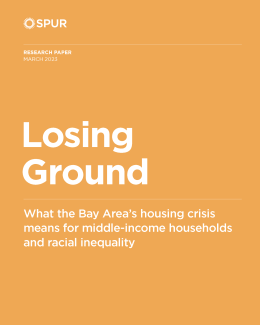What does it mean to be a middle-income resident of the Bay Area? How have the region’s housing affordability challenges changed who can live here? What is happening to people who can’t afford housing in the Bay Area? And what can policymakers do to create housing options affordable for middle-income people who want to call the Bay Area home?
SPUR’s new research paper, Losing Ground: What the Bay Area’s Housing Crisis Means for Middle-Income Households and Racial Inequality, aims to identify how the Bay Area’s housing market has become shaped by scarcity and wide economic divides not only among income groups but also among races and ethnicities.
The dire picture captured by our research has implications for the region’s economic and racial diversity. We need to address housing scarcity by creating a healthy housing market — that is, one that creates enough market-rate housing to meet the demand and means of middle-income households and even the needs of some lower-income households. How? Develop policies that help those families that earn 80% to 120% of AMI, but also those that earn 60% to 80% of AMI; expand homeownership opportunities; ensure that Black and Latinx households are able to access them; and learn from places that do a better job of producing middle-income housing.
Read an interview with the author
Watch our short film about the impact of the housing crisis on one family:
Bad Math: The SF Middle-Income Housing Crisis from SPUR on Vimeo.
